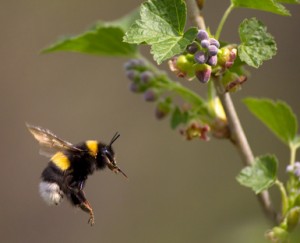

Unlike wasps or honeybees, bumblebees are usually not considered to be aggressive or dangerous. In fact, the fluffy black and yellow insect has been the inspiration for several songs, multiple poems and even fun cartoon characters. So –in homage to the bumblebee, here are some fun facts for you!
Although bumblebees create honey, they only create enough to live off of. If you find a nest with extra honey, it’s not a bumblebee nest.
The bumblebee collects nectar from plants and pollen from flowers as their food source. However, in collecting this nectar, they are also instrumental in pollinating the plants for future growth.
* The wings of a bumblebee move between 150 and 240 beats per second.
* They use the wings to help cool off the nest during warm summer months by hovering over the nest while flapping their wings.
* The male half of the bumblebee cannot sting as it does not have a stinger. The female will sting, but the stinger is not barbed, so it can sting multiple times in a row.
* However, bumblebees are not usually aggressive and will only sting as a defense mechanism.
* The antennae on a bumblebees head serve two purposes: to smell and to feel.
* It is unknown how bumblebees fly as they are not aerodynamically built. However, even though we humans can’t explain the flight, we enjoy watching them move lazily through the yard.
* Bumblebees hibernate underground.
* There are five species of bumblebees found in Florida. There are more than 300 species of bumblebees found throughout the world.
* The five species found in Florida include: The Southern Plains Bumblebee, the Twospotted Bumble Bee, the Brown-Belted Bumblebee, the Eastern Bumblebee and the American Bumblebee.
* Bumblebees can be found world-wide with the exception of the Arctic region.
* The bumblebee nest is ruled by a queen.
*It takes 21 days from the time a queen bee lays her eggs to the time that the new bees are hatched.
Although a bumblebee family will include the queen, female worker bees, new female queen bees and male drones, the new queen bees are the only ones that will hibernate and survive into the new year.
Due to the decreasing availability of wild flowers and wild pollinating plants, the number of bumblebee worldwide is also decreasing.
If you see a few bumblebees in your back yard, you don’t have much reason to fear. Bumblebee hives are relatively small and these types of bees don’t swarm or attack aggressively. In fact, if you do have flowering plants or trees, you may wish to leave them be as they are great pollinators. However, if you start to see a swarm or if they start to act aggressively, contact your pest control company as many other species of bees can be confused with the humble bumblebee.
